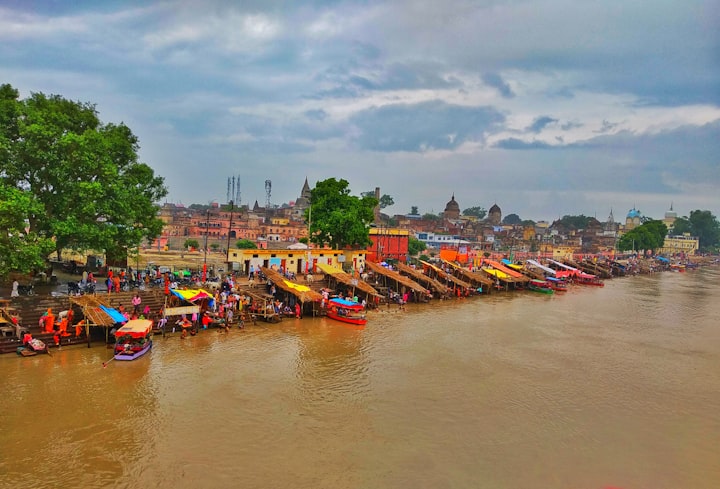Ayodhya Dham's Role in the Ramayana
Ayodhya

Introduction
Discover the fascinating role of Ayodhya Dham in the epic Ramayana, a tale that has captivated millions for centuries. Ayodhya Dham, also known as Ayodhya, holds immense significance as the birthplace of Lord Rama, the central character of the Ramayana. Located in the northern Indian state of Uttar Pradesh, this sacred city is a pilgrimage site for Hindus worldwide.
According to ancient texts, Ayodhya was ruled by the illustrious Ikshvaku dynasty, and it served as the capital of their kingdom. The Ramayana narrates the extraordinary journey of Lord Rama, who was exiled from Ayodhya for fourteen years, along with his loyal wife, Sita, and his devoted brother, Lakshmana. His subsequent adventures include encounters with powerful deities, legendary beasts, and a final battle against the demon king, Ravana.
Ayodhya Dham continues to be a place of devotion, where devotees flock to temples and take part in religious ceremonies. The city's rich history, architectural marvels, and spiritual atmosphere make it a cherished destination for those seeking a deeper connection with Hindu mythology and the teachings of Lord Rama. Join us as we explore the enduring legacy of Ayodhya Dham and delve into the timeless story of the Ramayana.
Historical Significance of Ayodhya
Ayodhya, with its ancient roots dating back thousands of years, holds immense historical significance. The city is believed to have been established by the legendary King Manu, the progenitor of humanity, according to Hindu mythology. Over the centuries, Ayodhya flourished under the rule of various dynasties, including the Ikshvaku dynasty, which is prominently mentioned in the Ramayana.
The Ikshvaku dynasty, known for its benevolent rule and adherence to dharma (righteousness), transformed Ayodhya into a prosperous city. The kingdom's well-planned infrastructure, magnificent palaces, and grand temples reflected its opulence and spiritual fervor. Ayodhya became a center of art, culture, and learning, attracting scholars, sages, and seekers of wisdom from far and wide.
Ayodhya in Hindu Mythology
Ayodhya occupies a significant place in Hindu mythology. As the birthplace of Lord Rama, it is revered as a sacred site and considered one of the seven holiest cities in India. According to Hindu beliefs, Ayodhya is one of the seven moksha puris (cities of salvation) where salvation from the cycle of birth and death can be attained.
The ancient scriptures describe Ayodhya as a divine city blessed by the gods themselves. It is said that Lord Brahma, the creator of the universe, chose Ayodhya as the site for his divine incarnation as Lord Rama. The city's celestial aura and spiritual vibrations are believed to have been infused by the presence of numerous deities and sages who resided here.
Ayodhya in the Ramayana
The epic Ramayana, written by the sage Valmiki, is an enchanting tale that unfolds in the backdrop of Ayodhya. It narrates the life and adventures of Lord Rama, who is considered the seventh avatar (incarnation) of Lord Vishnu. The Ramayana is divided into seven books, known as Kandas, each capturing a different phase of Lord Rama's life.
The Birth of Lord Rama in Ayodhya
The Ramayana begins with the birth of Lord Rama in Ayodhya. King Dasharatha, the ruler of Ayodhya, performed a grand yagna (sacrificial ritual) to please the gods and seek progeny. As a result, the gods blessed him with four sons, with Lord Rama being the eldest. The birth of Lord Rama brought immense joy and prosperity to Ayodhya, and the city celebrated with fervor and grandeur.
Lord Rama's Kingdom in Ayodhya
After King Dasharatha's demise, Lord Rama was set to inherit the throne of Ayodhya. However, his stepmother, Kaikeyi, manipulated the situation and demanded that Lord Rama be exiled to the forest for fourteen years. Despite the heartbreak and injustice, Lord Rama willingly accepted his fate and left Ayodhya, accompanied by his wife Sita and brother Lakshmana.
The Exile of Lord Rama from Ayodhya
During their exile, Lord Rama, Sita, and Lakshmana embarked on a journey filled with hardships, trials, and tribulations. They encountered various sages, ascetics, and mythical beings who imparted invaluable wisdom and showcased the power of devotion and righteousness. The Ramayana vividly describes their adventures in the forests, their encounters with demons, and their unwavering commitment to dharma.
The Return of Lord Rama to Ayodhya
After completing their fourteen years of exile, Lord Rama, Sita, and Lakshmana returned to Ayodhya. The city was engulfed in joy and festivity as the citizens welcomed their beloved prince and celebrated his homecoming. Lord Rama's triumphant return marked the beginning of a new era of peace, prosperity, and righteousness in Ayodhya.
Ayodhya as a Pilgrimage Site
Ayodhya's association with Lord Rama and the Ramayana has transformed it into an important pilgrimage site for Hindus. Devotees from all over the world visit Ayodhya to pay homage to Lord Rama and seek blessings for their spiritual journey. The city is adorned with magnificent temples dedicated to Lord Rama, Sita, Lakshmana, and other deities associated with the Ramayana.
The most revered temple in Ayodhya is the Ram Janmabhoomi, which is believed to be the exact location of Lord Rama's birth. This temple complex attracts millions of devotees each year, who come to offer their prayers and participate in religious ceremonies. The city's serene ghats (steps leading to the river) along the sacred Sarayu River provide a tranquil setting for devotees to perform rituals and immerse themselves in the divine atmosphere of Ayodhya.
Conclusion: Ayodhya's Enduring Legacy in the Ramayana
Ayodhya Dham's role in the Ramayana is a testament to the city's profound spiritual significance and its connection to Hindu mythology. As the birthplace of Lord Rama, Ayodhya holds a special place in the hearts of millions of devotees worldwide. The timeless story of the Ramayana continues to captivate and inspire people, reminding them of the power of righteousness, devotion, and the triumph of good over evil.
Through its rich history, architectural wonders, and spiritual sanctity, Ayodhya invites seekers of knowledge and spiritual enlightenment to immerse themselves in the divine essence of the Ramayana. As pilgrims walk through its sacred streets and offer their prayers at its holy temples, Ayodhya continues to shine as a beacon of hope, faith, and devotion, keeping the legacy of the Ramayana alive for generations to come.
About the Creator
Shwet Prabha Baiswar
Hey there! I'm Shwet Prabha, your friendly neighborhood blogger. Dive into my world of words where curiosity meets content. Let's make this journey together—because every word counts! #BlogLife #ExploreWithMe
Reader insights
Nice work
Very well written. Keep up the good work!
Top insights
Easy to read and follow
Well-structured & engaging content
Excellent storytelling
Original narrative & well developed characters
Eye opening
Niche topic & fresh perspectives
On-point and relevant
Writing reflected the title & theme






Comments
There are no comments for this story
Be the first to respond and start the conversation.